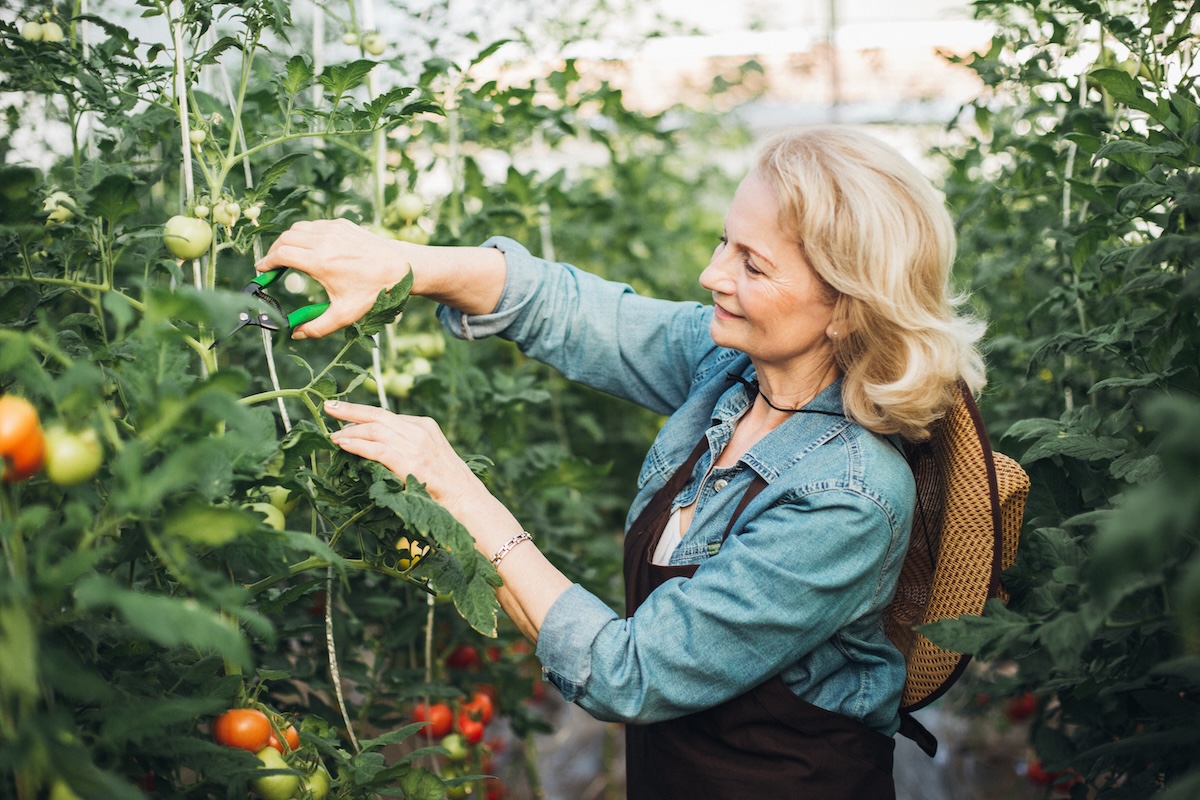

We may earn revenue from the products available on this page and participate in affiliate programs. Learn More ›
Tomatoes are America’s favorite garden “vegetable” to grow.Botanically a fruit, the tomato was classified as a vegetable by a U.S. tariff law in 1887 because it’s typically served with dinner, not as dessert.
Today, there are more than 10,000 varieties in many shapes, sizes, and colors. Given the right conditions—full sun, good soil, adequate water, drainage, and tomato cages or other plant supports—tomaato growing is pretty easy.
Plant care includes proper tomato plant pruning to increase airflow, thereby reducing fungal problems, and to encourage efficient photosynthesis for better growth and bigger yields. But novice gardeners are sometimes guilty of harmful tomato plant trimming mistakes that can damage the plants and reduce the yield.
How to Prune a Tomato Plant
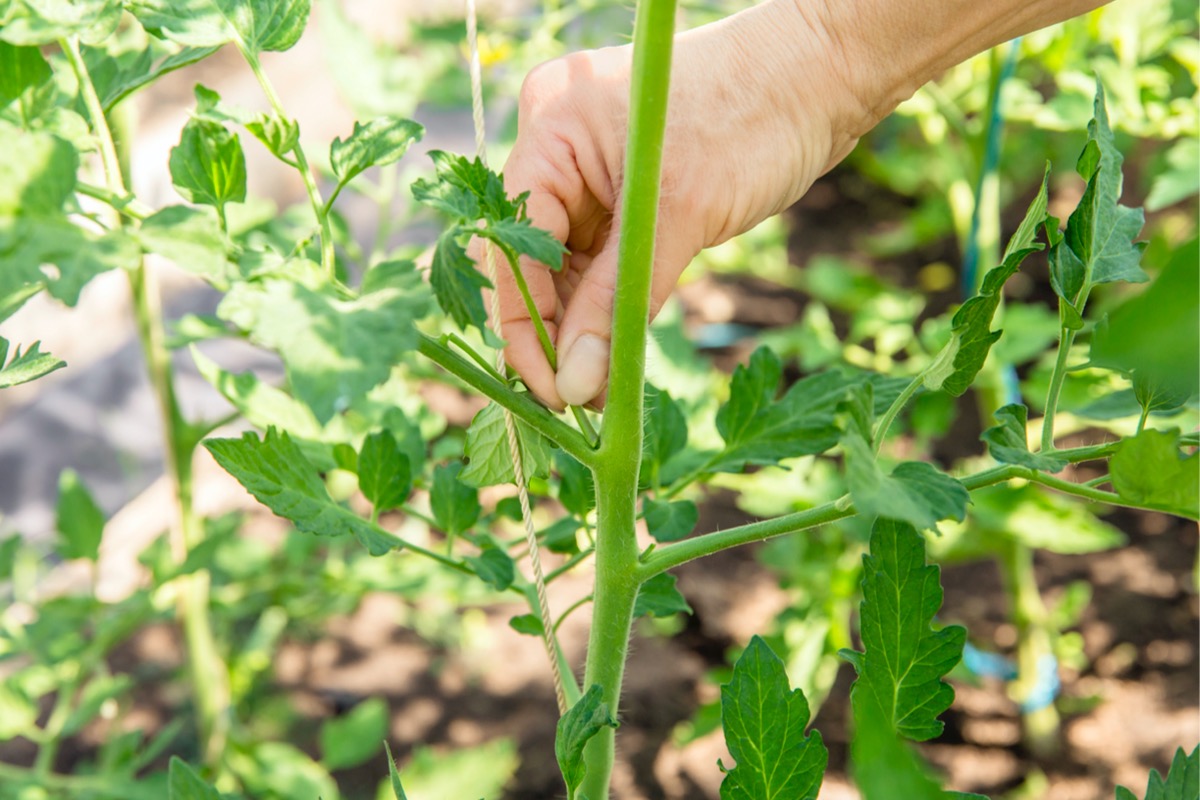
It might seem like there’s a fine line between a perfectly pruned tomato plant and an over-pruned tomato plant, but improper tomato pruning can result in problems. “When pruning tomatoes, the lower leaves are the main ones to take out as these can touch the soil and invite diseases,” says Samuel Davis, a horticulturist and the CEO of London Gardeners. If you’re not sure how to prune tomato plants or have had mixed results with tomato pruning in the past, read on for tips.
Simple Pruning
Suckers, which grow in the “V” between the main stem and the branches, need to be pruned to save energy for main branches (and the fruit they produce). Sucker pruning “directs the energy produced by your plant into producing fruit instead of an abundance of foliage,” says Davis. Suckering tomato plants also can prevent plants from crowding themselves and the space around them. Tomato plant suckers grow quickly; if left to grow into side stems, they tend to be spindly and produce inferior fruit. Pinch off suckers on a tomato plant that are less than 2 inches long), but if they’re bigger, pruners are necessary.
Missouri Pruning
This method is used when a tomato plant has grown large suckers. In Missouri pruning, a gardener pinches off or snips only the tip of the sucker, leaving a couple of tomato plant leaves behind to help protect developing fruit from sunburn. In this situation, removing just the tip is less of a shock to the plant than removing large side stems, particularly when the weather is hot. The downside of using this method is that the remaining portions of the suckers will grow new suckers, requiring ongoing pruning.
Tomato Pruning Mistakes to Avoid
Trimming tomato plants is necessary for optimal tomato plant health and yield, so don’t be afraid to prune! Just know the proper way and time to prune a tomato plant to avoid damaging the plant and jeopardizing your harvest. Here are some common tomato pruning mistakes to avoid.
1. Pruning determinate tomato plants.
Determinate tomato plants don’t need pruning, other than removal of suckers below the first flower cluster. Pruning above the first flower cluster results in loss of potential fruit because determinate tomato plants have a predetermined number of stems, leaves, and flowers hardwired into their genetic structure.
During a tomato plant’s initial phase, all stems and most of the leaves form, creating a defined pattern. After the plant flowers and sets final leaf expansion, there’s no additional vegetative growth. “Determinate varieties have been bred to grow to a certain size and then produce their entire fruit in a very short timeframe,” says Davis. Thus, there’s no need for additional pruning. Fewer cultivars are determinate types, but most determinates are more compact and require less staking. If you are unsure, just search the tomato variety name on a reputable site.
2. Pruning when the plants are wet.
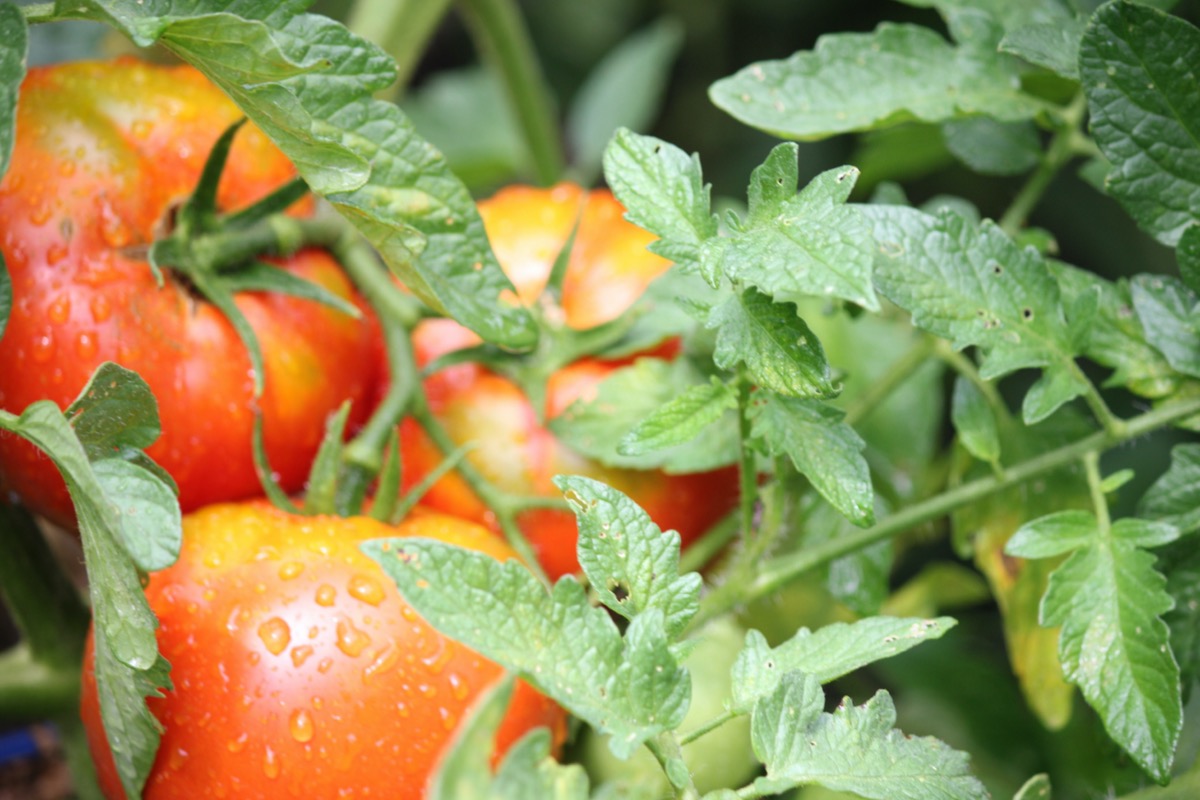
Pruning tomato plants when it’s raining or when they’re wet promotes the spread of disease—specifically, bacterial and fungal pathogens. One purpose of pruning tomatoes is to improve air circulation to thwart fungus. To further reduce chances of moisture-caused disease (such as tomato blight, a soilborne disease that causes rot), prune the lower leaves of the plant if they are touching the ground, particularly in wet climates where heavy rain saturates the soil.
3. Pruning with dull or dirty tools.
A pruner, or garden clipper, is the best tool to use on tomato plants. These spring-loaded hand tools can cut stems up to 1 inch in diameter. After a season of pruning your tomato plants, clippers can collect dirt, moisture, sap, and debris, which causes them to become dull or rusty. They also can spread disease from one plant to another. Applying a lubricant to the blades helps prevent rust and can make them easier to use.
Re-sharpening the blades with a knife sharpener (or replacing the blades) ensures they’ll give a clean cut. Dull blades will crush the stem rather than cut it, damaging the stem tissue.
4. Waiting too long to prune.
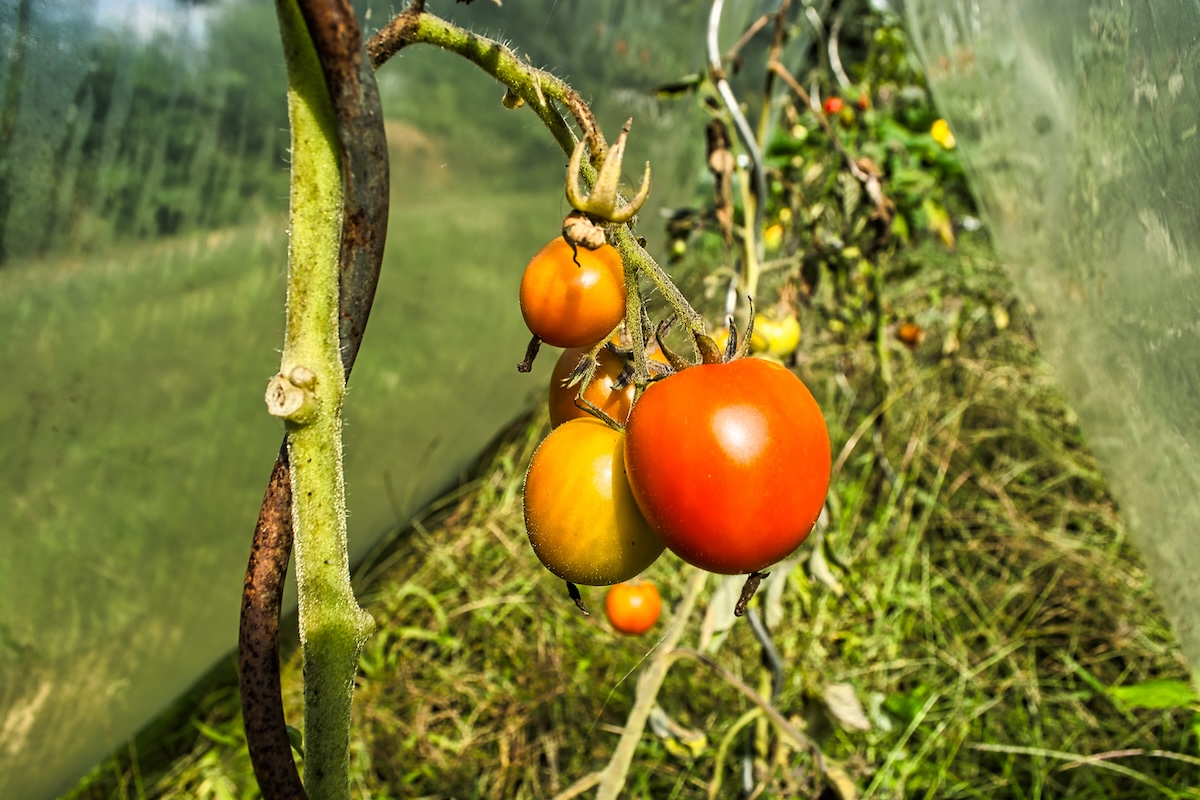
“Pruning should be started when the plant is still small to give it a head start during the growth season,” says Davis. If you put off pruning tomato plants too long, those little suckers will grow into large, heavy branches that can weigh down the plant, and prevent sunlight and air from getting to its stem. In addition, those suckers-turned-branches use up a lot of the plant’s energy that could have been diverted to producing more and bigger fruit. Be sure to “prune very early in the morning,” Davis says, when plants are dry.
5. Over-pruning.
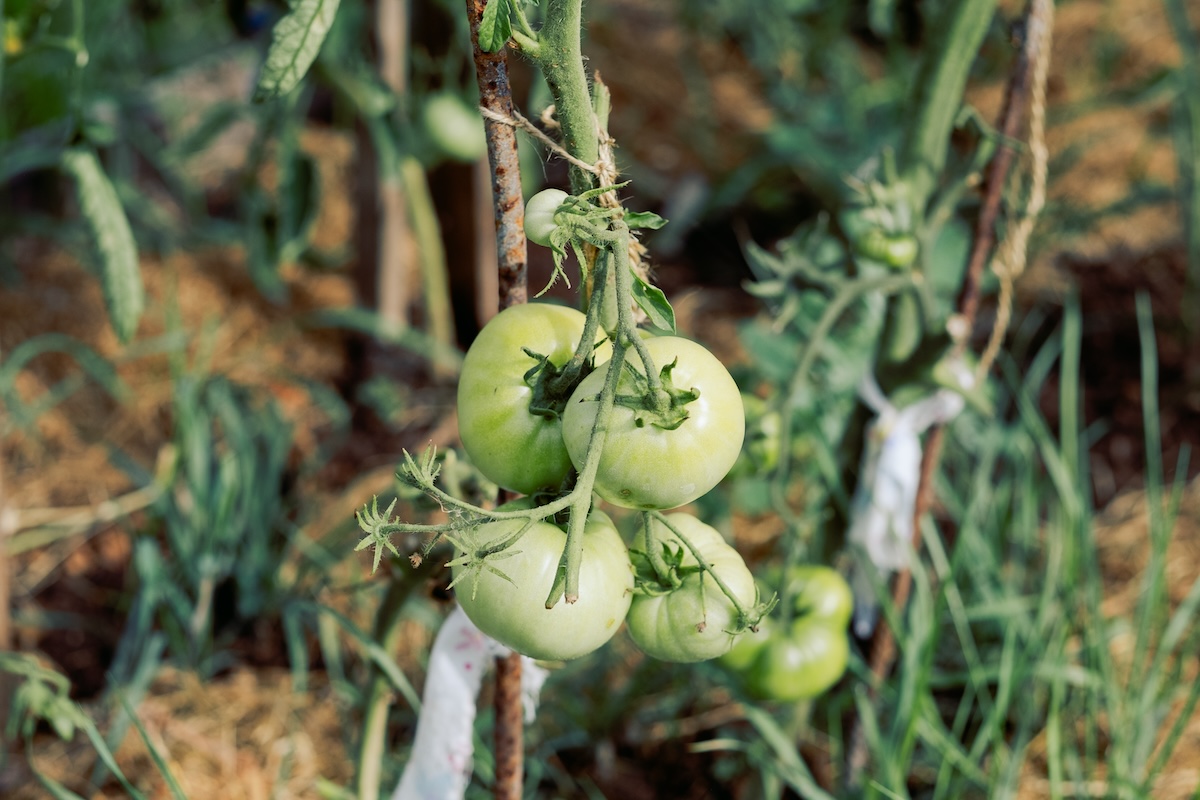
Over-pruning removes too many shade-producing leaves, resulting in the fruit being exposed to the hot sun, causing sun scald. “Over-pruning stresses the plant, reduces photosynthesis, and results in lower production with an increase in disease,” says Davis. “The key is to strike a balance in this tug-of-war-prune enough to keep them growing and producing healthily, but not so much (that) you stress them out.”
Removing more than one-third of the foliage at a time can do more than burn the fruit; it can result in the plant dying. Instead, prune tomato plants lightly after they finish setting fruit to keep the plants smaller and encourage new growth, which leads to more flowering and fruiting.
Hint: Tomatoes don’t set fruit in extremely hot temperatures, so the shade from those branches (and maybe some shade cloth) can cool down the tomato plant.
6. Not topping the main stems at the end of the growing season.
When time is running out near the end of the growing season, topping the growing tips will redirect the sugar the plant is producing to the setting fruit. It should be done about 30 days before the first frost for best results.
Called “topping the plant,” it involves pruning the terminal shoot just above the last blossom, and will help achieve a bigger harvest of red tomatoes, as opposed to mostly green tomatoes as the season winds down. Your pruning will help developing fruit get the nutrients that would have gone into new growth, which is unnecessary this late in the growing season.
